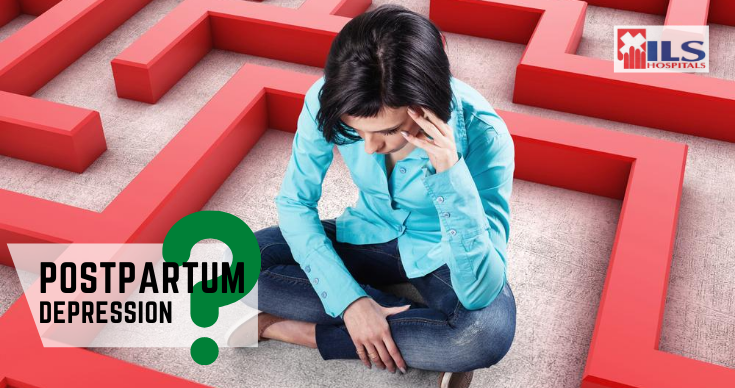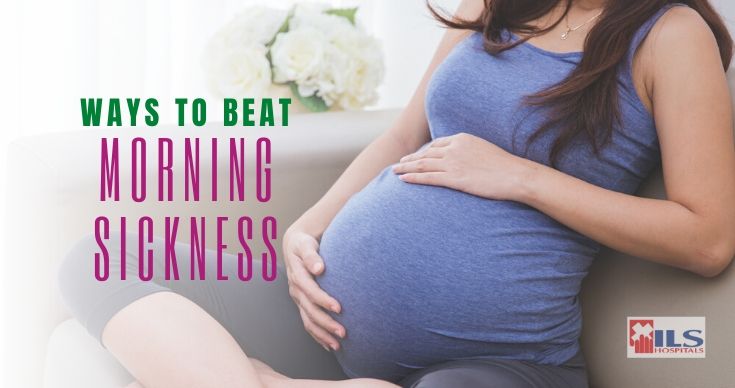Childbirth: ILS Hospitals’ Guide On Postpartum Depression
Pregnancy and childbirth are incredible experiences but for some women, they can also become overwhelming. Sometimes, pregnancy and delivery are not sunshine and rainbows because baby blues are real. Baby blues are a psychological condition felt by women right after delivery. When you have baby blues, you feel unhappy and emotionless for no reason. Usually, baby blues go away on their own within a week but in case if a new mother has baby blues that last longer than two weeks then she might be suffering from postpartum depression.
(Get premium care during pregnancy and childbirth from ILS Hospitals, the best maternity hospital in Kolkata and Agartala)
Postpartum depression is a serious mental condition that happens to new mothers post childbirth due to psychological and hormonal changes in the body. You’re more at risk of developing postpartum or postnatal depression if you fall under the following criteria:
- History of depression or other mental disorder
- Do not have support from the spouse, family, and friends
- Lack of sleep
- Have an unwanted and unplanned pregnancy
- Dealing with a financial crisis
- Living a stressful life
- Genetics.
Symptoms of Postpartum Depression
- Feeling sad and hopeless
- Mood swings
- Frequent crying without any reason
- Insomnia or hypersomnia (sleeping too much)
- Anxiety
- Poor appetite
- Difficulty concentrating
- Anti-social behaviour
- Anhedonia (not enjoying things that were once enjoyable)
- Thoughts of hurting the baby or oneself.
If you have the above symptoms that persist for more than one or two weeks, do not delay getting medical treatment.
Treatment for Postpartum Depression
Once you’ve been diagnosed by the healthcare professional for postnatal depression, you might be prescribed the following treatment:
- Talk therapy
- Medications – mostly antidepressants
- Electroconvulsive or shock therapy (in severe cases when the above methods don’t work)
Visit ILS Hospitals, one of the best hospitals in Agartala and Kolkata to get an accurate diagnosis and effective treatment for postpartum depression.
6 Best Ways To Manage Morning Sickness During Pregnancy
With pregnancy comes various other health issues, many a time leading to complications as well. One such common health issue associated with pregnancy is morning sickness or nausea and vomiting. Majority of pregnant women deal with morning sickness during the first trimester of their pregnancy.
According to gynaecologists from the best maternity hospital in Kolkata, morning sickness comes to an end during the 12-14 weeks of pregnancy (onset of the second trimester). Although the name is morning sickness, nausea and vomiting can happen at any time of the day. Morning sickness is very difficult to manage, therefore ILS Hospitals, one of the best hospitals in Kolkata and Agartala will show you 6 best ways through which you can easily manage morning sickness during pregnancy.
Eat small and frequent meals
Instead of eating big 2-3 meals a day, opt for small and frequent 5-6 meals a day. This will help a lot to curb nausea.
Snack healthily
Do not stay empty stomach for a long time. Because an empty stomach can make your morning sickness worse. Eat healthy snacks, like makhana or fox nuts, poha, upma, oats, sandwiches, soups, healthy cold fruit and vegetable juices, nutrition bars, etc.
Skip nausea-triggering foods
Avoid foods that trigger your nausea. In general, foods that amplify morning sickness are fried and fatty foods, acidic foods, odorous foods (onions), and spicy foods.
Try ginger
Ginger has helped a good percent of pregnant women during their morning sickness. If ginger works for you, try drinking ginger black tea, ginger ale, and ginger lozenges.
Avoid strong fragrances
Strong smells might aggravate nausea in some women. Do not wear perfumes with a strong scent. Avoid using room fresheners with high fragrance and stay away from cigarette smoke.
Take plenty of rest
Get 8-9 hours of sleep every night. If possible, sleep for a few hours during noon.
Consult an expert gynaecologist
Consult an expert gynaecologist and ask him or her to prescribe you anti-nausea medicines.
You can get a medical consultation from our renowned gynaecologists by visiting our hospitals in Agartala and Kolkata.
Facts About C-Section Every Expecting Mother Should Know Of
Bringing a life to the world is both amazing and challenging. A successful term of pregnancy ends up with a successful birth, which occurs either naturally or surgically. Most maternity hospitals nowadays assist in both natural and caesarean birth. Earlier the number of caesarean birth (also known as C-section) was very limited, but nowadays more and more cases are being noted. This advanced procedure helps many complicated births, but several myths surround it that makes many pregnant women avoid it on purpose.
Let’s burst 5 common myths regarding the same.
Myth 1 – It is Risky
Fact – Like any surgical procedure, it has certain risks attached to it. But so is with natural birth, where the use of forceps can cause injury to both mother and child. It is safe to conclude that a C-section from the hands of experts is possessed no long-term threats whatsoever. In fact, in many cases, it is a lot safer than natural birth.
Myth 2 – It is Always An Emergency Procedure
Fact – Many C-sections are indeed done on an emergency procedure. But, it can be elective as well. Maternity hospitals are observing that many women these days actually prefer the C-section due to its benefits.
Myth 3 – It is Only For High-Risk Pregnancies
Fact – Most high-risk pregnancies and breech babies are advised for C-section to mitigate risks associated with natural birth. But there is no thumb rule for it. Any women can choose to have her baby through this procedure if she feels it is the right one for her.
Myth 4 – It is Impossible To Deliver Naturally After A C-Section
Fact – Earlier, it was quite a changeling and considered so. These days, it is not only possible but actually is practiced by many women. It is more professional called VBAC (Vaginal Birth after Caesarean).
Myth 5 – C-Section Makes a Less of a Mother
Fact – No. Absolutely not. No matter how a baby is born, a mother is a mother. She is every bit of strong and commendable.
So, don’t let the silly myths stop you from considering the C-section for your baby if you feel it is the better option out of the 2.
Always remember the quote, by Laura Stavoe Harm: “There is a secret in our culture and it is not that birth is painful but that women are strong”.
7 Common Types of Pelvic Diseases
There are various and sometimes few fatal issues related to our pelvic organ that might affect our lives. An experienced gynecologist can solve most of these if consulted on time.

The most common pelvis related issues are mentioned in the following points:
1. Pelvic Inflammatory Disease (PID): PID is a disease that occurs in the female reproductive organs such as the uterus, ovaries, fallopian tubes, and cervix. It is usually caused due to a sexually transmitted infection (STI) like gonorrhea or chlamydia. PID can also cause serious issues if remained untreated and one might have trouble in getting pregnant or may have persistent pelvic pain throughout.
2. Vulvodynia: Recently, doctors have discovered that pelvic pain may also arise due to muscle tissues and irritation in nerves, which they specifically named as Vulvodynia. It has no definite reason of cause but it might occur due to previous yeast infection, soreness, dehydration, chronic stress, and depression. Pain or burning may be around external vagina walls, G-spot and so forth.
3. Endometriosis: It is a condition where an abnormal endometrial tissue grows in a place outside the uterus. Even this disease have no specific reason for a cause but if not treated may lead to infertility. The pain will occur during intercourse, urination or bowel movements.
4. Primary dysmenorrhea/Menstrual Cramps: Commonly, we are all aware of the cramp during the menstrual periods but if it exists even after 7 days, it is possible that the pain could be also the reason of some other issues. Usually, menstrual cramps occur due to irregular bleeding or spotting.
5. Urinary Incontinence: It is one of the most common pelvic diseases that are found in women and also in men. It is especially found in women. It may happen due to many reasons such as stress incontinence, urge, and overflow, mixed, functional and sometimes gross total incontinence.
6. Pelvic Congestion Syndrome: PCS is one of the common syndrome found among the women under the age of 45 who have gone through 2 or 3 pregnancies. It is very rare in women with no pregnancy record.
7. Infections: The most common type of pelvic disease also includes vaginal infections. There a quite a number of different infections that are faced by the female at least for once in their lifetime. This includes infections such as Yeast infection, Bacterial vaginosis, Trichomonas, etc.
Therefore, these are the few common types of pelvic or vaginal related disease that might trouble a woman’s life. If you show symptoms or is suffering from any of the above-mentioned diseases, feel free consult a certified and highly experienced Gynecologists to provide you the best service with proper guidance.
What Is Low Birth Weight And Its Main Causes
After a full term of pregnancy, a baby is born with body weight ranging between 2500 to 4200 grams in order to live a normal functional life. However, very often some of these babies are born with exceptionally lesser weight than medically considered as ideal. These babies need critical care and are often kept at special care units of maternity hospitals.

As per World Health Organization, babies having a body weight of 2499 grams or less are considered as low birth weight. This is further subdivided into very low birth weight (having less than 1500 gram) and extremely low birth weight (having less than 1000 grams).
Having a low birth weight puts the baby subjected to developing a wide number of medical complications, both in short term and in long term.
Causes of low birth weight
The low birth weight is either caused due to preterm birth or due to being small for the gestational or environmental factor of the prenatal growth and development.
Preterm birth
The gestational period ideally consists of 37 weeks and any pregnancy than matures before this duration is considered as preterm birth. Being born before the ideal time than the baby is supposed to, results in making the baby susceptible to multiple medical issues and being born with a low birth weight is one of them.

Being small for gestational age
As already mentioned, the gestational duration does play an important role. However, some babies born with low birth weight even with a full term. This happens when the baby is doing full term but is underdeveloped with respect to his or her age. It is often a result of some or the other medical or genetic condition. As any malnourished individual would perform less and will be less immunized, the rules apply same for an infant only to a bigger proportion.

Environmental factors
Several factors such as a young age of mother, previous low birth weight babies, multiple pregnancies, poor nutrition, substance abuse and malnourished prenatal stage etc contribute towards negatively affecting the birth weight of the baby. It also includes exposure to smoke, pollutant air, water, lead and other toxic substances as well.

As already mentioned, the babies having a low birth weight is highly likely to suffer immense adverse health conditions. Thus, every family having an expectant mother is advised to take proper care of the mother and the child in every aspect to ensure a safe pregnancy and healthy child. In case of any doubt, it is always wise to approach a maternity hospital as soon as possible.















